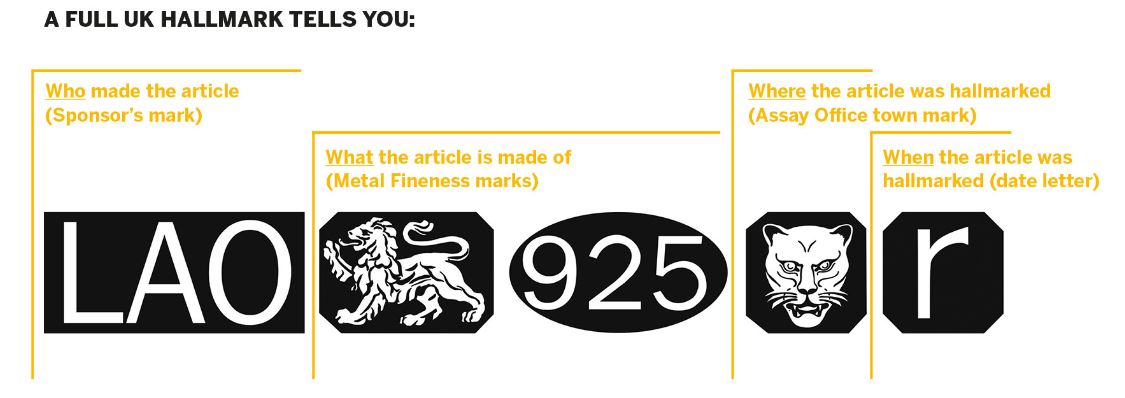There are many ways people describe the content of silver in jewellery. 925 silver, sterling silver, solid silver, fine silver, and silver plating are some examples of this. At times it can become confusing; so, we’re here to help make sense of it all.
Solid Silver

Silver can come in its purest form of 99.9% also known as fine silver. This pure silver is a fairly soft metal which means, although it’s pure, it can scratch and bend more easily. To help harden the metal a small amount of copper is added to form the alloy sterling silver. Sterling silver is 92.5% in purity, hence its alternative name of 925 silver.
So, when looking for silver jewellery, most people want this 925 or sterling version of the metal. But how can you know for sure that you’re getting the real deal?
Hallmarks
How do you know if it's real silver?
The best way to identify sterling silver is by looking for these stamped hallmarks by The Assay Office who test, certify, and stamp precious metals.

Here the 925 and lion hallmark symbols indicate the piece to be solid sterling silver throughout. This is why we use The Assay Office at Silver Hollow Jewellery to stamp and certify all silver pieces over a certain weight. Just a simple 925 stamp alone can indicate a piece to be sterling silver, however, some cheap manufacturers use this on metals which aren’t genuine 92.5% purity, so watch out for cheap jewellery that seems too good to be true!
The classic design of the traditional British hallmarks is a big inspiration for some of our designs at Silver Hollow Jewellery. Check out our 925 Hallmark silver ring which was designed with a gothic old English custom stamp that we think captures this heirloom quality.
Silver plating
Silver plate is another variety used in jewellery where a base metal (often steel or a copper alloy) is coated with a layer of silver. This is a cheaper alternative to solid silver pieces. This can, however, wear away after a few years, and needs to be kept away from repeated exposure to water for best care results. Hallmarks identifying this type of silver can include EPNS (Electro-Plated Nickle Silver), A1, and sometimes even S925 when some large manufacturers want to confuse people further! Other names for this type of silver include continental silver, Sheffield plate, electroplate, and nickel silver.
Many coins and cutlery pieces are made from different types of silver plating. Some are made from solid silver metal at different fineness (70%-99%). In general, the best quality silver to wear as jewellery is at least 70% in purity if you don't want it to leave a discoloured mark on your skin which can sometimes be caused by slight reactions to metals such as copper or nickel. This is especially important for wearing earrings, as sometimes an earring can be made from low- quality metal and cause irritation of a piercing.
How to care for your silver jewellery
Ever wondered what's the best way to take care of your silver jewellery? Will silver jewellery tarnish? Maybe you want to know how to polish your silver rings, necklaces or bracelets.
For the most part, sterling silver will keep its shine for years on end. When genuine 925 silver is worn it shouldn't tarnish much at all, as long as you avoid scratching it by wearing it while doing manual labour and other similar tasks that would risk this.
But can water cause silver to tarnish? We recommend avoiding contact with water where possible for best care results. Although solid sterling silver shouldn't tarnish much because of this, repeated contact with water will slowly reduce the polish of silver and cause tarnishing to happen faster. With silver plated jewellery and lower purity alloyed silver, this can result in your pieces needing a clean or polish more often if you want to keep them looking shiny and new. After a few years of poorly maintaining silver plated jewellery corrosion can wear away the layer of silver completely.
How to clean silver jewellery
To help bring new life to your silver jewellery there are a variety of silver cleaning and polishing options. Soap and warm water can even do the trick if you're looking for a quick and easy way to clean your jewellery. A standard jewellery wipe, polishing cloth or cleaning solution is a great cheap and convenient way to keep your jewellery shiny.

Even a microfibre cloth or iron wool (if you have these lying around the house) can do a great job of removing tarnish on sterling silver rings, silver chains, and silver bracelets.
We don't recommend using methods such as baking soda, detergent or toothpaste to clean silver jewellery. These products are often slightly acidic or alkaline which can cause corrosion, fading, colour changes and abrasive marking of silver.
If all else fails Silver Hollow Jewellery is happy to provide a complete re-finish, polish, and clean of your tarnished treasured pieces, whether it's antique silver handed down from a loved one or a special silver necklace that you want to revive.
At Silver Hollow Jewellery we use certified recycled solid sterling silver and have our heavier pieces hallmarked by The Assay Office. Silver-plated spoons are another material we use for our sustainable jewellery. All material content is stated in our item descriptions- if you have any questions feel free to reach out to us!

